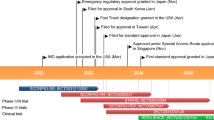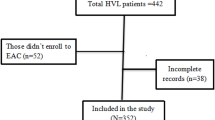Abstract
To assess the prevalence of major drug resistance mutations in antiretroviral (ARV)-treated patients with detectable viral load (VL) in Kuala Lumpur, Malaysia, genotypic resistance testing was performed among treated human immunodeficiency virus type 1 (HIV-1) patients attending the University Malaya Medical Center between July 2003 and November 2004. The reverse transcriptase (RT) and protease genes from 36 plasma samples with detectable VL were examined for major mutations associated with ARV resistance as reported by the International AIDS Society-USA Drug Resistance Mutations Group. The prevalence of patients with at least one major mutation conferring drug resistance to nucleoside RT inhibitors (NRTIs), non-NRTIs (NNRTIs) or protease inhibitors (PIs) was 77.8%. In the RT gene, the frequency of mutations associated with NRTIs and NNRTIs resistance was 52.8 and 63.9%, respectively, with M184V and K103N mutations being selected most frequently by these drugs. A patient with Q151M mutation complex was also detected. Twenty-two percent of the patients had mutations associated with PIs. The following pattern of prevalence of ARV-resistant HIV-1 variants was observed: NNRTI-resistant > NRTI-resistant > PI-resistant. The prevalence of major drug resistance mutations among ARV-treated patients with detectable VL is high in Kuala Lumpur. Genotypic drug resistance testing is therefore important for monitoring patients experiencing ARV regimen failure.

Similar content being viewed by others
References
Kamarulzaman A, Petoumenos K, Lee CK, Ariffin N, Tan LH, Kaldor J, Dore G (2004) Trend in ARV use in HIV-infected patients in Kuala Lumpur, Malaysia [ThPeB7132]. Presented at: XV International AIDS Conference, Bangkok
Yeni PG, Hammer SM, Carpenter CC, Cooper DA, Fischl MA, Gatell JM, Gazzard BG, Hirsch MS, Jacobsen DM, Katzenstein DA, Montaner JS, Richman DD, Saag MS, Schechter M, Schooley RT, Thompson MA, Vella S, Volberding PA (2002) Antiretroviral treatment for adult HIV infection in 2002: updated recommendation of the International AIDS Society-USA Panel. JAMA 288:222–235
Garcia F, Romeu J, Grau I, Sambeat MA, Dalmau D, Knobel H, Gomez-Sirvent JL, Arrizabalaga J, Cruceta A, Clotet BG, Podzamczer D, Pumarola T, Gallart T, O’Brien WA, Miro JM, Gatell JM (1999) A randomized study comparing triple versus double antiretroviral therapy or no treatment in HIV-1-infected patients in very early stage disease: the Spanish Earth-1 study. AIDS 13:2377–2388
Palella FJ Jr, Delaney KM, Moorman AC, Loveless MO, Fuhrer J, Sattern GA, Aschman DJ, Holmberg SD (1998) Declining morbidity and mortality among patients with advanced human immunodeficiency virus infection. HIV outpatient study investigators. N Engl J Med 338:853–860
Montaner JS, Reiss P, Cooper D, Vella S, Harris M, Conway B, Wainberg MA, Smith D, Robinson P, Hall D, Myers M, Lange JM (1998) A randomized, double-blind trial comparing combinations of nevirapine, didanosine, and zidovudine for HIV-infected patients: the INCAS trial. Italy, The Netherlands, Canada and Australia study. JAMA 279:930–937
Hammer SM, Squires KE, Hughes MD, Grimes JM, Demeter LM, Currier JS, Eron JJ Jr, Feinberg JE, Balfour HH, Deyton LR, Chodakewitz JA, Fischl MA (1997) A controlled trial of two nucleoside analogues plus indinavir in persons with human immunodeficiency virus infection and CD4 cell counts of 200 per cubic millimeter or less. N Engl J Med 337:725–733
Conway B, Wainberg MA, Hall D, Harris M, Reiss P, Cooper D, Vella S, Curry R, Robinson P, Lange JM, Montaner JS (2001) Development of drug resistance in patients receiving combinations of zidovudine, didanosine and nevirapine. AIDS 15:1269–1274
Ross L, Johnson M, DeMasi R, Liao Q, Graham N, Shaefer M, St Clair M (2000) Viral genetic heterogeneity in HIV-1-infected individuals is associated with increasing use of HAART and higher viremia. AIDS 14:813–819
DeGruttola V, Dix L, D’Aquila R, Holder D, Phillips A, Ait-Khaled M, Baxter J, Clevenbergh P, Hammer S, Harrigan R, Katzenstein D, Lanier R, Miller M, Para M, Yerly S, Zolopa A, Murray J, Patick A, Miller V, Castillo S, Pedneault L, Mellors J (2000) The relation between baseline HIV drug resistance and response to antiretroviral therapy: re-analysis of retrospective and prospective studies using a standardized data analysis plan. Antivir Ther 5:41–48
Tee KK, Pon CK, Kamarulzaman A, Ng KP (2005) Emergence of HIV-1 CRF01_AE/B unique recombinant forms in Kuala Lumpur, Malaysia. AIDS 19:119–126
Beyrer C, Vancott TC, Peng NK, Artenstein A, Duriasamy G, Nagaratnam M, Saw TL, Hegerich PA, Loomis-Price LD, Hallberg PL, Ettore CA, Nelson KE (1998) HIV type 1 subtypes in Malaysia, determined with serologic assays: 1992–1996. AIDS Res Hum Retroviruses 14:1687–1691
Tee KK, Kamarulzaman A, Ng KP (2006) Low prevalence of genotypic drug resistance mutations among antiretroviral-naïve HIV-1 patients in Malaysia. AIDS Res Hum Retroviruses 22, (in press)
Johnson VA, Brun-Vezinet F, Clotet B, Conway B, Kuritzkes DR, Pillay D, Schapiro JM, Telenti A, Richman DD (2005) Update of the drug resistance mutations in HIV-1: Fall 2005. Top HIV Med 13:125–131
Yerly S, Kaiser L, Race E, Bru JP, Clavel F, Perrin L (1999) Transmission of antiretroviral-drug-resistant HIV-1 variants. Lancet 354:729–733
Sethi AK, Celentano DD, Gange SJ, Moore RD, Gallant JE (2003) Association between adherence to antiretroviral therapy and human immunodeficiency virus drug resistance. Clin Inf Dis 37:1112–1118
Fellay J, Marzolini C, Meaden ER, Back DJ, Buclin T, Chave JP, Decosterd LA, Furrer H, Opravil M, Pantaleo G, Retelska D, Ruiz L, Schinkel AH, Vernazza P, Eap CB, Telenti A, (2002) Swiss HIV cohort study response to antiretroviral treatment in HIV-1-infected individuals with allelic variants of the multidrug resistance transporter 1: a pharmacogenetics study. Lancet 359:30–36
Adje C, Cheingsong R, Roels TH, Maurice C, Djomand G, Verbiest W, Hertogs K, Larder B, Monga B, Peeters M, Eholie S, Bissagene E, Coulibaly M, Respess R, Wiktor SZ, Chorba T, Nkengasong JN (2001) UNAIDS HIV drug access initiative, Abidjan, Cote d’Ivoire high prevalence of genotypic and phenotypic HIV-1 drug-resistant strains among patients receiving antiretroviral therapy in Abidjan, Cote d’Ivoire. J Acquir Immune Defic Syndr 26:501–506
Vergne L, Malonga-Mouellet G, Mistoul I, Mavoungou R, Mansaray H, Peeters M, Delaporte E (2002) Resistance to antiretroviral treatment in Gabon: need for implementation of guidelines on antiretroviral therapy use and HIV-1 drug resistance monitoring in developing countries. J Acquir Immune Defic Syndr 29:165–168
Kantor R, Zijenah LS, Shafer RW, Mutetwa S, Johnston E, Lloyd R, von Lieven A, Israelski D, Katzenstein DA (2002) HIV-1 subtype C reverse transcriptase and protease genotypes in Zimbabwean patients failing antiretroviral therapy. AIDS Res Hum Retroviruses 18:1407–1413
Havlir DV, Hellmann NS, Petropoulos CJ, Whitcomb JM, Collier AC, Hirsch MS, Tebas P, Sommadossi JP, Richman DD (2000) Drug susceptibilities in HIV infection after viral rebound in patients receiving indinavir-containing regimens. JAMA 283:229–234
Descamps D, Flandre P, Calvez V, Peytavin G, Meiffredy V, Collin G, Delaugerre C, Robert-Delmas S, Bazin B, Aboulker JP, Pialoux G, Raffi F, Brun-Vezinet F (2000) Mechanisms of virologic failure in previously untreated HIV-infected patients from a trial of induction-maintenance therapy. JAMA 283:205–211
Iversen AK, Shafer RW, Wehrly K, Winters MA, Mullins JI, Chesebro B, Merigan TC (1996) Multidrug-resistant human immunodeficiency virus type 1 strains resulting from combination antiretroviral therapy. J Virol 70:1086–1090
Pellegrin I, Izopet J, Reynes J, Denayrolles M, Montes B, Pellegrin JL, Massip P, Puel J, Fleury H, Segondy M (1999) Emergence of zidovudine and multidrug-resistance mutations in the HIV-1 reverse transcriptase gene in therapy-naïve patients receiving stavudine plus didanosine combination therapy. STADI Group. AIDS 13:1705–1709
Coakley EP, Gillis JM, Hammer SM (2000) Phenotypic and genotypic resistance patterns of HIV-1 isolates derived from individuals treated with didanosine and stavudine. AIDS 14:F9–F15
Nettles RE, Kieffer TL, Simmons RP, Cofrancesco J Jr, Moore RD, Gallant JE, Persaud D, Siliciano RF (2004) Genotypic resistance in HIV-1-infected patients with persistently detectable low-level viraemia while receiving highly active antiretroviral therapy. Clin Inf Dis 39:1030–1037
Zennou V, Mammano F, Paulous S, Mathez D, Clavel F (1998) Loss of viral fitness associated with multiple Gag and Gag-Pol processing defects in human immunodeficiency virus type 1 variants selected for resistance to protease inhibitors in vivo. J Virol 72:3300–3306
Alatrakchi N, Duvivier C, Costagliola D, Samri A, Marcelin A, Kamkamidze G, Astriti M, Agher R, Calvez V, Autran B, Katlama C (2005) Persistent low viral load on antiretroviral therapy is associated with T cell-mediated control of HIV replication. AIDS 19:25–33
Hirsch MS, Brun-Vezinet F, Clotet B, Conway B, Kuritzkes DR, D’Aquila RT, Demeter LM, Hammer SM, Johnson VA, Loveday C, Mellors JW, Jacobsen DM, Richman DD (2003) Antiretroviral drug resistance testing in adults infected with human immunodeficiency virus type 1: 2003 recommendations of an International AIDS Society-USA Panel. Clin Inf Dis 37:113–128
Acknowledgements
The authors would like to thank the staff in the HIV/Viral Hepatitis Laboratory, Infectious Diseases Unit and Pediatric Unit at UMMC, Kuala Lumpur for their involvement in this study. The authors also like to thank Prof. Lam SK for his critical review of the manuscript. This study was supported by the IRPA grant (06-02-03-1015) from the Ministry of Science, Technology and Innovation, Malaysia.
Author information
Authors and Affiliations
Corresponding author
Rights and permissions
About this article
Cite this article
Tee, K.K., Kamarulzaman, A. & Ng, K.P. Prevalence and pattern of drug resistance mutations among antiretroviral-treated HIV-1 patients with suboptimal virological response in Malaysia. Med Microbiol Immunol 195, 107–112 (2006). https://doi.org/10.1007/s00430-005-0010-x
Received:
Published:
Issue Date:
DOI: https://doi.org/10.1007/s00430-005-0010-x




